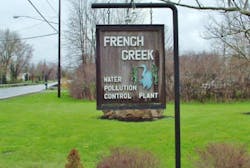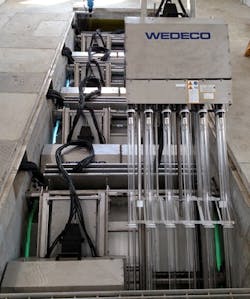North Ridgeville is a warm, neighborly, and growing city of 32,483 located in Lorain County in Northeast Ohio. It was founded in 1810 and incorporated as a city in 1960. The city is located 15 minutes from Cleveland Hopkins International Airport and 30 minutes from Downtown Cleveland. At 25 square miles, it is the largest city in land area and third largest in population in Lorain County.
The French Creek Wastewater Treatment Plant (WWTP) is wholly owned and operated by the citizens of North Ridgeville. The plant serves North Ridgeville, Avon, and Sheffield through main underground interceptor sewer lines. North Ridgeville took full ownership of the sewer treatment facility in the latter part of 2008. The plant services about 12,500 accounts through nearly 300 miles of pipeline, which ultimately returns the treated effluent to French Creek.
The WWTP was built in 1975 by the Ohio Water Development Authorities and was purchased from the State of Ohio by the City of North Ridgeville in 1983. While the plant is only a few decades old, North Ridgeville has continually upgraded and maintained its operations. The city has invested millions of dollars to ensure that the plant remains current with technology and in compliance with everchanging environmental guidelines.
Scope
Although the WWTP is ready to serve its growing customer base well into the future with safe, sanitary, and cost-effective treatment of sewage, it was dealing with a dilapidated ultra-violet (UV) system installed in 2000 as their disinfection source. The equipment was very labor intensive. For example, wiring for the lamps was routed inside the lifting arms. As the wiring aged, it would wear out causing a short. It was very difficult to “fish” the wire through the arm. Ballast assemblies were located above the channel and were cooled by a glycol loop. Loop tubing leaked, which made the ballast area slippery. The city was also finding it difficult to locate replacement parts, as the manufacturer was slowly rendering the equipment obsolete. Finally, the UV system was consuming a large amount of power as it inched closer to the end of its life.
The city needed to identify a replacement UV system that fit into the same channel, offered lower power consumption, and contained a practical ease of maintenance to reduce the amount of labor consumed on the equipment.
Solution
Working closely with the city’s consulting engineer, Jones & Henry Engineers, Ltd., Toledo, OH, North Ridgeville selected the Wedeco Duron UV system over other inclined UV systems based on an evaluated bid including a 20 year life cycle cost analysis due its energy efficiency and the ease of maintenance this system is offering. According to the client the removal of the old system was fairly straightforward. The existing channel was utilized as the Duron UV banks are actually narrower than the existing space. The area where the existing UV system was located was demolished and a new level control gate structure was constructed.
Result
The Duron UV system is designed to treat 22 MGD and can be upgraded to a future peak design flow of 32 MGD by adding an additional UV bank. Wedeco’s UV system not only results in lower capital cost, but lower energy consumption as well. OptiDose, the sensor-based, real-time dose control, monitors operating conditions including flow, UV transmittance (UVT), and UV intensity. Then, with proven control logic, OptiDose adjusts the energy consumption to the minimum needed to meet dosing requirements so that the right dose is delivered using the minimum amount of energy.
Central to the design is how easily and efficiently the system is maintained and serviced. Obviously, large scale component replacement has decreased since the Duron system is new. Easy lamp replacement can be conducted while the modules remain in the channel. Dry-top UV lamp access and the compact, integrated, lifting mechanism allow safe and ergonomic maintenance, including inspection of the UV sensor, a new task for the operators.
Cleaning is simple and safe thanks to the Duron’s automatic, chemical-free Opti Wipe system. Wipers consist of unique PTFE and FKM rings, proven effective even in waters with high fouling potential.
Simply put, Duron is a 45-degree, inclined, open-channel UV system possessing an integrated, compact, automatic-lifting device and featuring energy-efficient, high-power Ecoray lamps and was the perfect answer to the French Creek Wastewater Treatment Plant’s requirements.
Editor's Note: Scranton Gillette Communications and the SGC Water Group are not liable for the accuracy, efficacy and validity of the claims made in this piece. The views expressed in this content do not reflect the position of the editorial teams of Water & Wastes Digest, Water Quality Products and Storm Water Solutions

